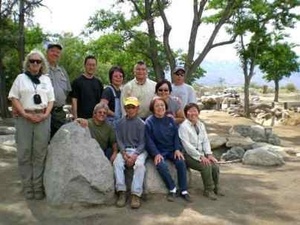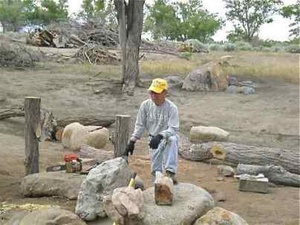Read Part 1 >>
Laying the Foundation
Amos, Robert, and Brian used an auger drill to bore four holes where the main posts of the bridge would be placed, two on each side of the bridge. The crew had to drill pretty deep in order to provide a sturdy anchor for the rest of the bridge, as each post weighed over a hundred pounds and measured about six feet tall with only two feet being exposed above ground.
Once the holes were drilled out, the crew had to lift and carefully place each post as closely as possible as they appeared in the photographs. The photographs only provide perspectives on one side of the bridge so Amos had to estimate a match on the other side.
The crew planted each post until finally all four posts were firmly in place. Amos and Burton carefully studied the photographs to ensure the two main posts resembled, as closely as possible, the posts in the photographs supplied by Burton. The photographs included those by Ansel Adams and other internee families.
The family returned the next morning to install two long logs as “stringers,” which were used to span the bridge providing the foundation and support for the bridge walkway.
A documentary film crew from the Japan Public Broadcasting organization NHK had arranged to film Henry and document the initial construction of the bridge. They arrived early and started with having Henry walk in a nearby meadow with the Eastern Sierras as a backdrop and then asked him a few interview questions before joining the family in preparing to move the first stringer into place.
The approach to install the first of the stringers must have been similar to what was done in 1943. The crew placed two, 4 x 4 planks across the span and placed a few logs across on the planks. The crew then hoisted one end of an 18-foot stringer on to the first “roller” and inched it across the span. The stringer had a natural curve and, therefore, a natural tendency to turn on to one side. Additionally, the logs weighed an estimated 850 pounds or more. As such, the crew had to push it across the planks a few inches at a time, constantly correcting its course, until it was positioned across the planks.
Once the stringer reached the other end, the crew had to prepare to turn the log into place. As Amos and Robert pondered some potential solutions, 93-year-old Henry jumped right in to dig out a receiver for one end of the stringer while the camera crew took the opportunity to film one of many contributions Henry made in recreating his father’s vision.
Some additional digging and a few cuts later, the crew tilted the stringer and adjusted it until it was perfectly placed and ready to be buried.
Once the first stringer was firmly in place, the family took a break while John Kepford of the National Park Service Maintenance Division went to retrieve the other log with a backhoe. During the break, the NHK crew took the opportunity to interview Robert, Patrick, Iris, Henry, and Brian on their feelings about the project, what it represented, and what it meant to them to be part of this historical milestone.
After the interview, fellow internee, 89-year-old Arthur Ogami and his wife, Kimi, were brought over by their son. The NHK crew filmed them speaking to each other about their experiences in Manzanar and about camp life. Arthur had been an orderly at the hospital and had contributed to the construction of the hospital garden, Merritt Park, and other gardens at Manzanar.
Kepford arrived with the second stringer loaded on a backhoe and suggested using a harness to secure it in place.
Now you might think this method would be faster and easier, but actually, it required a lot of thought and maneuvering, and installation turned out to be as difficult as the first stringer for different reasons. The crew had the benefit of experiencing both an old method and a modern method of installing the two stringers.
Amos noted that the stringers “were arched and had other features to consider when balancing.” He added, “Adjustments needed to be periodically applied to keep the weight in motion, basically we moved the tree using its own energy. The opposite was true when the backhoe lifted the stringer and we had to use our energy to maneuver the piece into place. It is always humbling to see that come together and that nature has its laws.”
To install the second stringer held by the backhoe, Patrick and Iris had to pull on one end of the stringer to guide it and keep it from straying. At the same time, Amos and Robert had to cut the stringer in certain places, and dig out some of landing area to prepare it to fit exactly into place.

Front row (from left): Barry Amos, Henry Nishi, Amy Nishi, Carol Nishi. Back row (from left): Mary Burton, Jeff Burton, Brian Teraoka, Sherry Ota, Patrick Alvarado, Iris Alvarado, Robert Nishi. Photo: Patrick Alvarado.
The crew maneuvered the stringer in place and turned it, but it was not quite right, so they had to raise it again, cut the log, and dig a bit more to get it to rest just right. Finally, the crew got the stringer in place and braced it with a log. Although the crew buried it well, they left the bracing log in place to keep the stringer stable until they return for the next phase.
The NHK film crew took a final filming shoot with Henry pondering the bridge, and then took a group photo of the family with Burton and his wife Mary, using the bridge in the distance on the right as a background.
The restoration of Merritt Park wouldn’t be possible without the support of the descendants and extended family of Kuichiro Nishi, donations made to the Friends of Manzanar, and the time and labor contributed by Manzanar volunteers. The completion and preservation of Merritt Park and other historic landscaping and structures within the Manzanar National Historic Site greatly benefit from individual donations and contributions.
*This article was originally published on May 31, 2011 on the Official Blog of the Manzanar Committee.
© 2011 Patrick Alvarado






